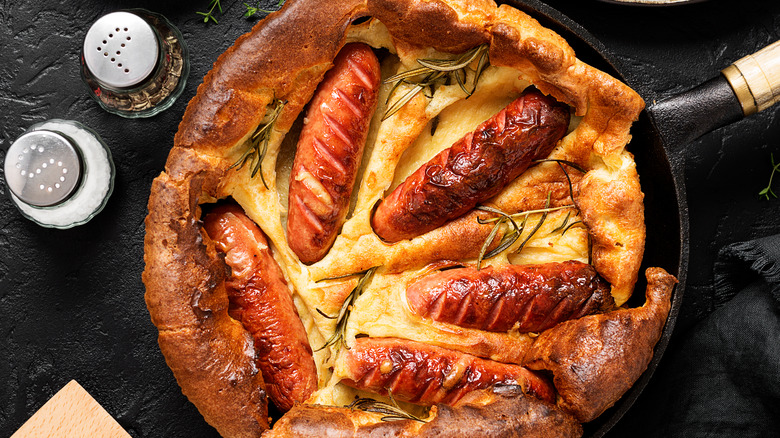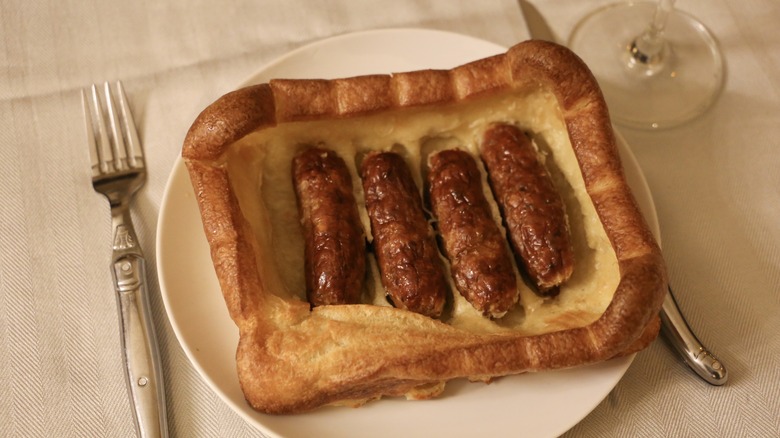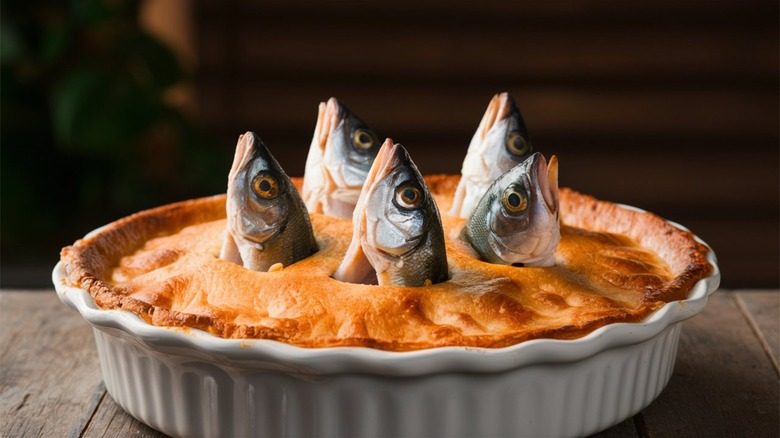How Toad In The Hole Became An Iconic English Breakfast
We may receive a commission on purchases made from links.
There's nothing more appetizing than the idea of an amphibian nestled in a cozy little hole ... right? British dish monikers have a habit of confounding (and amusing) unfamiliar American palates, and toad in the hole is a prime example. Far from containing anything as untoward as actual toads, toad in the hole is a traditional British meal of sausages baked into a fluffy, savory batter known as Yorkshire pudding.
The origin of the name is something of a mystery, other than the widely held assumption that someone likened the sight of the sausages poking out of the batter to the image of a toad peeking out of its hole in the ground. A tenuous comparison at best, but — for whatever reason — the name stuck.
The primary cause that the dish solidified itself as an iconic British breakfast is likely because it was a cost-effective, filling, and tasty way to use leftovers or inexpensive staples one might have around the home. Although sausage (or 'bangers' as the British call them) is the star of the dish nowadays, any leftover scraps of meat or offal were on the menu back in the 18th century when the dish probably originated.
A history of of toad in the hole variations
Meat was expensive and families were large, so this recipe provided a clever method for spreading protein out among multiple, calorie-rich servings. The original recorded versions of toad in the hole, back when it was called "toad in a hole," did not include sausage. In 1747, Hannah Glasse outlined how to make "pigeon in a hole" in her book "The Art of Cookery." The first known use of the term "toad in the hole" can be found in "The Oxford English Dictionary's" reference to a 1787 provincial glossary, describing the meal simply as any kind of meat cooked in a crust.
The dish's place in society must have been well-solidified by 1861 when Mrs. Beeton included a recipe in her well-known "Book of Household Management." Hers calls for steak and kidney, but she did specify that this savory recipe could be made with any leftover meat.
This breakfast has a strong reputation for being working-class comfort food. As such, even Queen Victoria's cook Charles Elme Francatelli recommended buying the cheapest possible meat for the dish, and Alexis Soyer suggested using leftover bits of beef, veal, pork, fowl, or mutton in his acclaimed 1850 book "The Modern Housewife." As time went on, sausage became the usual meat to include in the staple.
Other iconic British meals with curious names
Toad in the hole is not the only curiously-named meal that has proved a long-lasting place in British society. Bangers and mash have an explosive name dating back to WWI when meat was scarce, so sausages had fillers added that caused them to pop as they cooked. Bubble and squeak is an 18th-century comfort food that uses leftovers. Made up of leftover vegetables and potatoes, the name comes from the sounds the ingredients make when they are fried up over the stove into a crispy-edged patty.
Spotted dick is another British dish with a name that tends to raise some eyebrows among the uninitiated. The Victorian Era meal is a steamed pudding, or what non-UK residents know as a steamed cake, served with a creamy custard. The dish is made with suet (hard, white animal fat) and dried fruit — the latter of which is the source of the "spots" in the dessert.
The whimsically-named stargazy pie dons a crown of sardines and is another interesting one. This savory pie stands out because of the whole fish heads that poke out of the crust, gazing upward at the skies. The dish has roots in the Cornish town of Mousehole where a fearless fisherman braved winter storms to save the town from near starvation with a large catch of fish. The subsequent fish pies were baked with the heads poking out to prove the fish was real, and the rest is history.



